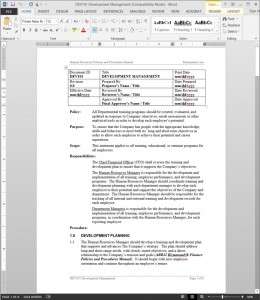Organizational Learning: Competence Awareness and Training

An organization that values learning is very likely to be an organization that more readily embraces change, including improved technologies and methods. Also, while job-related training is important, a broad approach to encouraging all kinds of educational opportunities really promotes a learning culture.
While there are abundant educational avenues that should be open for employees and managers to pursue, learning and education should not be done haphazardly. The path should be carefully selected and focused on meeting the needs of the company and the needs of the employees. While all learning does not have to come with a huge fee, a commitment to learning should be reflected in an organization’s budget, as well.
Create a Learning Plan
The first step is to effective training is to create a learning plan for each member of the organization, from the top executive to the cleaning staff. The learning plan should address direct job-related learning as well as professional development and general education goals. In order to set job-related training goals, access the employee skills and competencies needs.
Employee Competence
While a variety of education and training should be encouraged and made available, the most important aspect of learning should be making sure the employee is competent in their job and is expanding the skills and knowledge they need to do their job effectively more effectively in the pursuit of continuous improvement.
Employee Learning Plan
The learning plan should address in detail what kind of training program is needed in order to improve or develop particular job skills and knowledge, and that includes where and how it can be achieved and what time frame. In other words, create a set of clear objectives. Sometimes a competency matrix is used to describe the skill needs of a position and the current skill levels of an associate in order to do a gap assessment.
It is important, however, to frame this exercise properly. Associates should never be made to feel that they are deficient or lacking; the focus should be on improvement and getting better. Once again the organizational culture plays an important role. If learning and improvement are valued across the organization, then associates will be more likely to view their assessment and learning plan in a positive light.
Competence and Confidence
The manager should review the learning plan with an associate at least once a year. During this review it should be made clear what training the associate is responsible for finding and attending themselves, as well as what budget is available, and what will be scheduled for them. Other education and training goals, such as professional development and general education, should be discussed and documented as well.
Educational Goals
Consider whether particular goals can be accomplished formally or informally in-house, or if external classes are appropriate. This is also a great opportunity to encourage associates to set and work toward educational goals, and to make sure they are fully aware of company programs that encourage education like tuition reimbursement.
Educational Benefits
The benefits of direct job-related training are really too obvious and too numerous to go into with great detail here, but one aspect of a well-trained worker is often over looked. Knowledgeable, well-trained employees do their job with a sense of confidence.
We can all draw upon personal experience in order to relate to the difference between working or dealing with someone who displays confidence in taking on a task and achieving a positive result, as opposed to someone who seems hesitant and doubtful. Confident workers are also much more likely to realize, and experiment with, innovative methods and new technologies.
Training Resources
Learning does not have to be expensive. Training opportunities exist in-house and can be done for little expense. There are several key facets to consider with internal training. The first, as discussed above, must deal with developing key skills and competencies needed for top notch job performance.
Cross-Training
Cross-training is a great way to disperse organizational knowledge as well as create informal networks. Plus, it provides trained back-ups for key positions in the organization. Understanding your internal customer needs or the capabilities of your internal supplier can be a key factor in successfully aligning processes. What better way to understand suppliers and customers than to wear their shoes for a while?
If the order-entry group knows exactly what the shipping department does, and vice versa, the result can be improved interdepartmental cooperation and understanding. If possible, you may want to set up similar exercises with external customers and suppliers. There are numerous ways to make use of internal expertise and knowledge.
Training Alternatives
Two great examples of training alternative include:
- Mentoring: Let experienced employees show new hires the lay of the land
- Brown Bag Luncheons: Have internal experts give informal presentations on topics of broad interest
Of course, mentors and presenters might require training to prepare them for their tasks.
Another important learning consideration is communicating the organizations vision, mission, strategy, and objectives. Employees at all levels should be encouraged to create their own mission and objectives that align with the over-arching goals of the organization. How can they align their own objectives and tasks to the overall organizational strategies if they don’t even know what they are? Awareness and understanding the organization’s goals by every member should be a top priority of an organization’s leaders.
Find and Use Good Learning Providers
Whether it is communication skills, process training, or using technology, there are plenty of external sources for learning. Besides Bizmanualz, a great place to look is the local community college or university. Most offer a wide variety of relevant business classes during the day and evening.
For example, employees can learn database or programming skills, or they can enhance their presentation skills. Allowing them to attend classes during working hours shouldn’t automatically be excluded (as is usually the case). Perhaps they could attend an early morning class and still be at work at a reasonable time. Find innovative learning incentives, such as an automatic raise for degree or certificate completion, or a day off for successfully completing an evening class.
Learning Culture
It is most important to influence learning by first creating a culture of learning. The next important step is to make the most of the time and money you invest into learning. That involves creating thoughtful plans and strategies that combine direct training with more general education from a mix of internal or external sources. A learning plan should set goals and identify priorities. There are many ways to increase your training performance.
Everything, however, cannot be accomplished at once. It may be a multi-year process to achieve all the learning goals identified, let alone new requirements identified along the way. The most important thing is to get started on the learning path and nurturing a learning culture.

















Very informative and educative piece. I always find your well researched writings very beneficial.
Thanks.